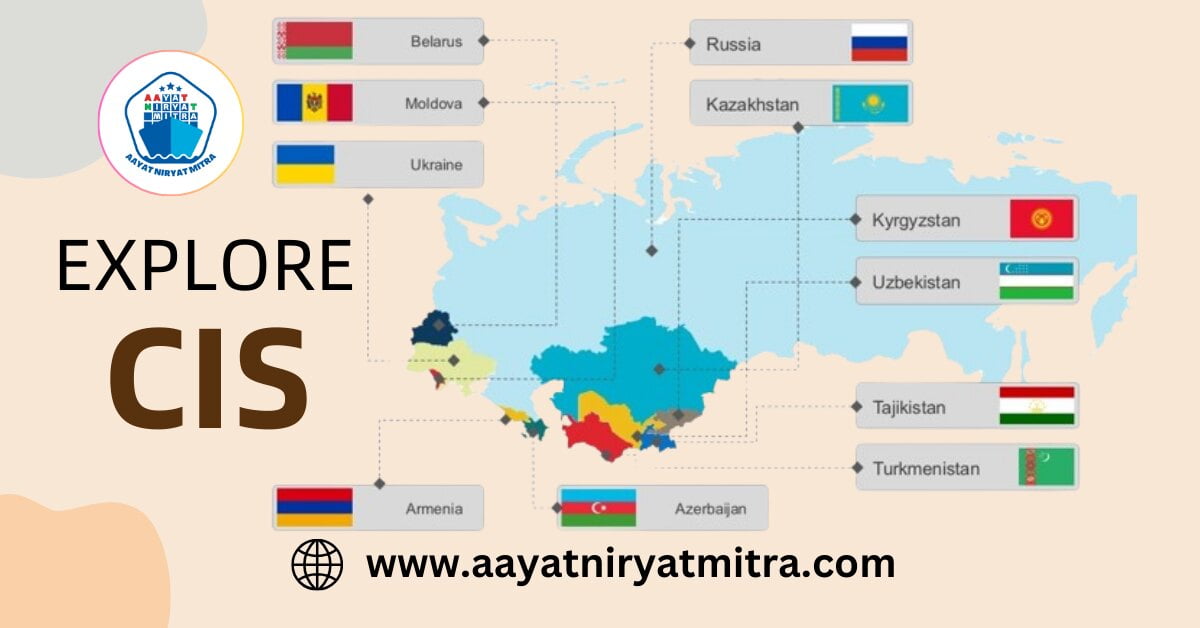India exports CIS vibrant agriculture and growing industries and finds a promising market in the CIS region. This blog explores the advantages and key products in India’s trade relationship with the CIS.
Introduction:
India, renowned for its rich agricultural heritage and dynamic industries, has made a significant impact on the global export market. India exports to 12 countries/ territories in the CIS group across 31 commodities. The Commonwealth of Independent States (CIS), which includes Armenia, Azerbaijan, Belarus, Georgia, Kazakhstan, Kyrgyzstan, Republic of Moldova, Russian Federation, Tajikistan, Turkmenistan, Ukraine, and Uzbekistan, offers a promising landscape for Indian exports. This blog explores India’s thriving trade relationship with the CIS, highlighting the benefits for Indian exporters and the wide range of products that connect these regions.
The Commonwealth of Independent States (CIS):
CIS stands for Commonwealth of Independent States. It’s a regional organization in Eurasia formed by some of the former Soviet republics after its dissolution in 1991. It isn’t a political union but aims to promote economic, political, and cultural cooperation among its member states. This article explores the CIS’s history, structure, and current significance on the global stage.
A Legacy of the Soviet Union:
The CIS was created to maintain cooperation among the former Soviet republics. While some members hoped for a closer political union, most preferred a more flexible association focused on economic collaboration.
Who Are the Members?
The CIS includes Twelve member states:
- Armenia
- Azerbaijan
- Belarus
- Georgia
- Kazakhstan
- Kyrgyzstan
- Republic of Moldova
- Russian Federation
- Tajikistan
- Turkmenistan
- Ukraine
- Uzbekistan
Structure and Functioning:
The CIS operates through several intergovernmental bodies, including the Council of Heads of State and the Council of Heads of Government. These bodies meet regularly to discuss common interests and coordinate policies. However, decision-making can be challenging due to the diverse interests of its members.
The CIS in the 21st Century:
Today, the CIS remains relevant in several areas:
- Economic Cooperation: Promotes free trade agreements and facilitates economic collaboration among members.
- Security: The Collective Security Treaty Organization (CSTO), a military alliance within the CIS, enhances regional security cooperation.
- Cultural Exchange: Encourages cultural programs and events to foster understanding and connections between member states.
The Future of the CIS:
The future of the CIS is uncertain. Some view it as a relic of the past, while others believe it still has a valuable role in regional cooperation. Its ability to adapt to global changes and address the needs of its members will determine its continued relevance.
Why does India Exports CIS? Advantages for Indian Businesses
- Established Trade Ties: India has long-standing trade relationships with several CIS countries, fostering trust and familiarity.
- Vast Market Potential: With a population of over 230 million, the CIS region offers a large consumer base for Indian goods.
- Complementary Economies: India’s diverse export products meet the needs of CIS economies, creating mutually beneficial trade opportunities.
- Government Initiatives: The Indian government actively promotes trade with the CIS through various initiatives and agreements.
- Geographical Proximity: Proximity to some CIS countries helps reduce transportation costs and delivery times.
India’s Top Exports to the CIS
India exports various products to the CIS, catering to diverse consumer needs. Key exports include:
- Pharmaceuticals: Indian life-saving and generic drugs are crucial in CIS healthcare systems.
- Agricultural Products: India’s Basmati rice, spices, and tea are popular in the CIS.
- Machinery & Electrical Equipment: India’s engineering sector exports vital machinery for the CIS’s industrial development.
- Textiles & Apparel: From intricately woven fabrics to ready-made garments, India’s textile industry caters to CIS fashion preferences.
- Chemicals: India’s chemical production expertise supports the CIS’s industrial sector.
India Export the following Products to CIS Country:
| Commodity View | Total Exports Apr’23 – Mar’24 ($Mn) | % Share in selected criteria Total exports |
|---|---|---|
| Engineering Goods | 1,643.43 | 29.23% |
| Drugs And Pharmaceuticals | 965.87 | 17.18% |
| Organic and Inorganic Chemicals | 528.32 | 9.40% |
| Electronic Goods | 487.63 | 8.67% |
| Others | 275.31 | 4.90% |
| Mica, Coal, And Other Ores, Minerals Including Process | 203.08 | 3.61% |
| Ceramic Products And Glassware | 179.96 | 3.20% |
| Marine Products | 162.82 | 2.90% |
| Fruits And Vegetables | 133.78 | 2.38% |
| Tobacco | 123.33 | 2.19% |
| Meat, Dairy And Poultry Products | 121.63 | 2.16% |
| Plastic And Linoleum | 110.05 | 1.96% |
| Tea | 99.22 | 1.76% |
| Coffee | 91.05 | 1.62% |
| Rice | 87.11 | 1.55% |
| Oil Seeds | 69.36 | 1.23% |
| Leather And Leather Manufactures | 67.48 | 1.20% |
| Ready-made garments of all textiles | 66.35 | 1.18% |
| Gems And Jewellery | 44.91 | 0.80% |
| Cereal Preparations And Miscellaneous Processed Item | 35.59 | 0.63% |
| Spices | 33.22 | 0.59% |
| Man-Made Yarn/Fabs./Madeups Etc. | 32.8 | 0.58% |
| Leather And Leather Manufacturers | 21.98 | 0.39% |
| Petroleum Products | 17.12 | 0.30% |
| Carpet | 10.19 | 0.18% |
| Handicrafts Excl. Hand Made Carpet | 5.41 | 0.10% |
| Oil Meals | 4.09 | 0.07% |
| Jute Mfg. Including Floor Covering | 1.79 | 0.03% |
| Other Cereals | 0.32 | 0.01% |
| Cashew | 0.16 | 0.00% |
| Iron Ore | 0 | 0.00% |
| Total | 5,623.36 | 100.00% |
FAQs on India Exports CIS:
-
Q: What are the CIS countries, and why are they relevant for Indian exports?
Ans: The Commonwealth of Independent States (CIS) includes Armenia, Azerbaijan, Belarus, Georgia, Kazakhstan, Kyrgyzstan, Republic of Moldova, Russian Federation, Tajikistan, Turkmenistan, Ukraine, and Uzbekistan. These countries are significant for Indian exports due to their large and diverse markets, established trade ties with India, combined population of over 230 million, and economies that complement India’s export basket.
-
Q: What are some of India’s top exports to the CIS countries?
Ans: India exports a wide range of products to the CIS, including:
Pharmaceuticals: Life-saving and generic drugs essential for CIS healthcare systems.
Agricultural Products: Basmati rice, spices, and tea that cater to CIS consumer preferences.
Machinery & Electrical Equipment: Contributing to the industrial development of CIS countries.
Textiles & Apparel: Meeting diverse fashion demands with fabrics and garments.
Chemicals: Catering to the industrial needs of the CIS region. -
Q: What are the advantages of exporting to the CIS for Indian businesses?
Ans: Established Trade Ties: Long-standing relationships foster trust and familiarity.
Large Market Potential: Over 230 million consumers across the CIS region.
Complementary Economies: India’s exports fill gaps in CIS economies, creating mutual benefits.
Government Support: Indian government initiatives and trade agreements facilitate exports.
Proximity: Geographical advantages reduce transportation costs for some CIS countries. -
Q: What are some challenges Indian exporters might face when exporting to the CIS?
Ans: Complex Customs Regulations: Navigating customs procedures can be challenging.
Logistics Considerations: Finding efficient and cost-effective transportation solutions.
Language Barriers: Communication hurdles due to language differences. -
Q: How can Indian exporters overcome the challenges of exporting to the CIS?
Ans: Consulting Experts: Partnering with logistics companies and trade consultants.
Market Research: Thoroughly researching regulations, import requirements, and market trends.
Localization Efforts: Considering language translations for marketing materials and packaging. -
Q: What resources are available for Indian exporters interested in the CIS market?
Ans: Ministry of Commerce and Industry (MoCI): MoCI Website provides trade data and resources.
Export Promotion Councils (EPCs): Industry-specific councils offer guidance and support.
Indian Missions in CIS Countries: Embassies and consulates provide local market insights. -
Q: Are there any trade agreements between India and CIS countries?
Ans: While there isn’t a single comprehensive agreement, India has bilateral trade agreements with several CIS countries that promote trade cooperation.
-
Q: How can Indian exporters stay updated on trade developments with the CIS?
Ans: MoCI Website: Regularly check for trade notifications and updates.
EPC Publications: Subscribe to industry council newsletters and reports.
Industry News Sources: Follow news outlets focused on international trade and the CIS region. -
Q: What are some future growth opportunities for India’s exports to the CIS?
Ans: Information Technology (IT): India’s IT expertise can cater to the CIS’s growing technological needs.
Renewable Energy Products: India’s advancements in solar panels and wind turbines offer sustainable solutions.
Engineering Goods: India’s engineering sector can provide high-quality machinery and equipment. -
Q: What are some success stories of Indian companies exporting to the CIS?
Ans: Researching successful case studies of Indian businesses exporting to the CIS can provide valuable insights and inspiration.
Conclusion:
The CIS region presents a lucrative opportunity for Indian exporters looking to expand their global presence. By leveraging established trade ties, a large consumer base, and government support, Indian businesses can tap into new markets and contribute to the growth of India’s export portfolio. Success in the CIS market requires thorough research, navigating potential challenges, and staying informed about market developments.
If you discover an error in the “India Exports CIS: A Lucrative Bridge in 2024“ information provided to us, please notify us immediately via the comment box and email; if the information provided by you is correct, We will change it.
If you enjoyed this article, please share it with your friends. Please visit Aayat Niryat Mitra | Import Export Friend for more information on this and other topics. Thank you for stopping by.

